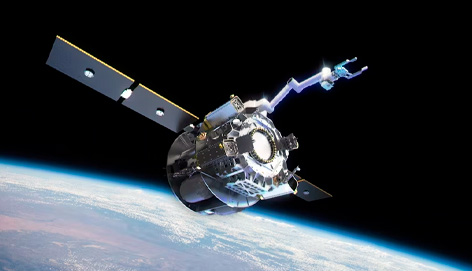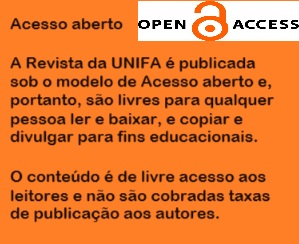Health research in microgravity:
a systematic literature mapping
DOI:
https://doi.org/10.22480/revunifa.2024.37.638Keywords:
Microgravity, Spaceflight, Health research, Microgravity researchAbstract
The state of microgravity, or more correctly micro weightiness, exists in an orbital vehicle in a state of free fall, i.e. without any force acting on it except for gravitational forces. This results in a stress and strain-free state, in which fluids show an altered behavior, making microgravity experiments essential for research in space science. Therefore, this study aims to identify trends and research opportunities in this field of knowledge, reducing this gap in the literature through a systematic literature mapping study. Of the studies identified in the PubMed, ScienceDirect, and Wiley Online Library databases, 242 were selected by inclusion and exclusion criteria. The journals that publish the most and their countries of origin were highlighted, especially NPJ Microgravity and the United Kingdom. It was also observed that the number of publications in this area has been growing, with its peak in the year 2021. Among the forms of study in microgravity, research on board the International Space Station and, on Earth, through hindlimb unloading stands out. The health areas with the highest number of research are musculoskeletal health and cell biology. Through this research, those interested in the topic may have a first contact or deepen and update their knowledge, in addition to using the open results to carry out other in-depth studies through a systematic literature review.
References
ANASUYA, B.; DEEPAK, K. K.; JARYAL, A. K. The Cardiovascular Variability during Transient 6 degrees Head Down Tilt and Slow Breathing in Yoga Experienced Healthy Individuals. Int J Yoga, 14, n. 3, p. 188-197, Sep-Dec 2021.
AXPE, E.; CHAN, D.; ABEGAZ, M. F.; SCHREURS, A. S. et al. A human mission to Mars: Predicting the bone mineral density loss of astronauts. PLoS One, 15, n. 1, p. e0226434, 2020.
BARBOSA, A. A.; DEL CARLO, R. J.; GALVÃO, S. R.; VILELA, M. J. et al. Bone mineral density of rat femurs after hindlimb unloading and different physical rehabilitation programs. Revista Ceres, 58, n. 4, p. 407-412, 2011.
BARTELS, R. Re-interpreting R² , regression through the origin, and weighted least squares. University of Sydney Business School. Available from: https://www.researchgate.net/profile/Robert-Bartels/publication/283333191_Re-interpreting_R-squared_regression_through_the_origin_and_weighted_least_squares/links/5634317e08aeb786b7014027/Re-interpreting-R-squared-regression-through-the-origin-and-weighted-least-squares.pdf. [Accessed: 08 August 2022].
BLABER, E.; MARÇAL, H.; BURNS, B. P. Bioastronautics: The Influence of Microgravity on Astronaut Health. Astrobiology, v. 10, n. 5, 2010.
BLOTTNER D.; PÜTTMANN, B.; SALANOVA, M.; SCHIFFL, G.; TIRRWEGER, J. et al. Skeletal Muscle Deconditioning, Nitric Oxide (NO) Biomarker, and Exercise Countermeasure - Five Years of Bed Rest Studies. Journal of Gravitational Physiology, 13(2), 49-58, 2006.
BREUNINGER, J.; BELSER, V.; LAUFER, R.; DROPMANN, M. et al. Design of a 1.5 Seconds High Quality Microgravity Drop Tower Facility. Transactions of the Japan Society for Aeronautical and Space Sciences, Aerospace Technology Japan, 14, n. ists30, p. Ph_7-Ph_14, 2016.
CHARLES, J. B. Bioastronautics Roadmap - A Risk Reduction Strategy for Human Space Exploration. National Aeronautics and Space Administration, Washington DC, Feb., 2005. Available from: https://humanresearchroadmap.nasa.gov/Documents/BioastroRoadmap.pdf. [Accessed: 08 August 2022].
CHOWDHURY, P.; LONG, A.; HARRIS, G.; SOULSBY, M. E. et al. Animal model of simulated microgravity: a comparative study of hindlimb unloading via tail versus pelvic suspension. Physiol Rep, 1, n. 1, p. e00012, Jun 2013.
DERMEVAL, D.; COELHO, J. A. P. de M.; BITTENCOURT, I. I. Mapeamento Sistemático e Revisão Sistemática da Literatura em Informática na Educação. In: JAQUES, P. A.; SIQUEIRA, S.; BITTENCOURT, I.; PIMENTEL, M. (Org.) Metodologia de Pesquisa Científica em Informática na Educação: Abordagem Quantitativa. Porto Alegre: SBC, 2020. Available from: https://metodologia.ceie-br.org/livro-2. [Accessed: 08 August 2022].
DUTRA, V. R.; VIEIRA, K. M.; SILVA, W. V. d.; KREUTZ, R. R. State-of-the-Art: A Systematic Review of the Literature on Financial Well-Being. Revista Universo Contábil, 16, n. 2, 2021.
EVANS, C.; ROBINSON, J.; TATE-BROWN, J. Research on the International Space Station: An Overview. In: 47th AIAA Aerospace Sciences Meeting including The New Horizons Forum and Aerospace Exposition, 2009, DOI: 10.2514/6.2009-186.
GARCIA, T. M.; SILVA, M. G. G.; NASCIMENTO, R. P. C. Mapeamento sistemático: adoção de padrões de interoperabilidade no governo. Revista Científica da FASETE, 1, 207-221, 2018.
HORNECK, G. Astrobiological aspects of Mars and human presence: pros and cons. Hippokratia, 1:49–52, 2008.
HARGENS, A. R.; VICO, L. Long-duration bed rest as an analog to microgravity. J Appl Physiol (1985), 120, n. 8, p. 891-903, Apr 15 2016.
HERRANZ, R.; ANKEN, R.; BOONSTRA, J.; BRAUN, M. et al. Ground-based facilities for simulation of microgravity: organism-specific recommendations for their use, and recommended terminology. Astrobiology, 13, n. 1, p. 1-17, Jan 2013.
KITCHENHAM, B.; BRERETON, P.; BUDGEN, D. Mapping study completeness and reliability - a case study. In: 16th International Conference on Evaluation & Assessment in Software Engineering (EASE 2012), 2012, p. 126-135. DOI: 10.1049/ic.2012.0016.
KLEIN, K. E.; BLUTH, B. J.; WEGMANN, H. M. Assessment of space station design and operation through bioastronautics. Acta. Astronaut, 17:207–212, 1988.
KREUTZ, R.; VIEIRA, K. M.; SILVA, W. V.; DUTRA, V. R. State-of-the-art: a systematic review of the literature on financial well-being. Revista Universo Contábil, v. 16, n. 2, p. 87-109, 2021.
MOREY-HOLTON, E. R.; GLOBUS, R. K. Hindlimb unloading rodent model: technical aspects. J Appl Physiol (1985), 92, n. 4, p. 1367-1377, Apr 2002.
NAPOLEÃO, B.; FELIZARDO, K.; SOUZA, É.; VIJAYKUMAR, N. Practical similarities and differences between Systematic Literature Reviews and Systematic Mappings: a tertiary study. In: Proceedings of the 29th International Conference on Software Engineering and Knowledge Engineering, p. 85-90, 2017. DOI: 10.18293/seke2017-069.
NICKERSON, C. A. Welcome statement-npj Microgravity. NPJ Microgravity, 1, p. 15006, 2015.
OLUWAFEMI, F. A.; FATOKI, T. H.; IBRAHEEM, O. Clinostat microgravity impact on root morphology of selected nutritional and economic crops. Plant Cell Biotechnology and Molecular Biology, v. 21, p. 92-104, 2020.
ORTER, S.; MOSTL, S.; BACHLER, M.; HOFFMANN, F. et al. A comparison between left ventricular ejection time measurement methods during physiological changes induced by simulated microgravity. Exp Physiol, 107, n. 3, p. 213-221, Mar 2022.
PETERSEN, K.; MUJTABA, S.; FELDT, R.; MATTSSON, M. Systematic Mapping Studies in Software Engineering, 2008. Available from: https://www.researchgate.net/publication/228350426. [Accessed: 08 August 2022].
PLETSER, V. Gravity, weight and their absence. In: Springer Briefs in Physics. Singapore: Springer Nature Singapore Pte Ltd, 2018. Available from: https://link.springer.com/book/10.1007/978-981-10-8696-0. [Accessed: 23 July 2022]. DOI: 10.1007/978-981-10- 8696-0.
PLETSER, V.; RUSSOMANO, T. Research in Microgravity in Physical and Life Sciences: An Introduction to Means and Methods. In: Preparation of Space Experiments, 2020. cap. Chapter 1.
RICHARDS, J. T.; TORRES, J. J.; GLEESON, J. R.; JOHNSON, C. M.; ZHANG, Y. Customized Science Carrier Modules and Accessories Developed for Microgravity Simulation Devices. NTRS - NASA Technical Reports Server, 2021. Available from: https://ntrs.nasa.gov. NASA/TP-20210021724. [Accessed: 23 July 2022].
ROGERS, M. J. B.; VOGT, G. L.; WARGO, M. J. Microgravity: A Teacher’s Guide with Activities in Science, Mathematics, and Technology (National Aeronautics Space Administration, Washington, 1997, Available in: www.nasa.gov/pdf/62474main_Microgravity_ Teachers_Guide.pdf. [Accessed: 23 July 2022].
SCHULZ, H.; DIETRICHS, D.; WEHLAND, M.; CORYDON, T. J. et al. In Prostate Cancer Cells Cytokines Are Early Responders to Gravitational Changes Occurring in Parabolic Flights. Int J Mol Sci, 23, n. 14, Jul 17 2022.
SHANMUGARAJAN, S.; ZHANG, Y.; MORENO-VILLANUEVA, M.; CLANTON, R. et al. Combined Effects of Simulated Microgravity and Radiation Exposure on Osteoclast Cell Fusion. Int J Mol Sci, 18, n. 11, Nov 18 2017.
SOAITA, A. M.; SERIN, B.; PREECE, J. A methodological quest for systematic literature mapping. International Journal of Housing Policy, 20, n. 3, p. 320-343, 2019.
VERNIKOS, J. Human Exploration of Space: why, where, what for? Hippokratia, v. 12, n. 1, p. 6-9, 2008.
WAISBERG, E.; ONG, J.; ZAMAN, N.; KAMRAN, S. A.; LEE, A. G.; TAVAKKOLI, A. A non-invasive approach to monitor anemia during long-duration spaceflight with retinal fundus images and deep learning. Life Sciences in Space Research, v. 33, p. 69-71, 2022.
WILLIAMS, D. R. Bioastronautics: optimizing human performance through research and medical innovations. Nutrition, v. 18, p. 794–796, 2002.
XU, D.; GUO, Y. B.; ZHANG, M.; SUN, Y. Q. The subsequent biological effects of simulated microgravity on endothelial cell growth in HUVECs. Chin J Traumatol, 21, n. 4, p. 229-237, Aug 2018.
ZHANG, Y. N.; SHI, W. G.; LI, H.; HUA, J. R. et al. Bone Loss Induced by Simulated Microgravity, Ionizing Radiation and/or Ultradian Rhythms in the Hindlimbs of Rats. Biomed Environ Sci, 31, n. 2, p. 126-135, Feb 2018.
ZHOU, Y.; NI, H.; LI, M.; SANZARI, J. K. et al. Effect of solar particle event radiation and hindlimb suspension on gastrointestinal tract bacterial translocation and immune activation. PLoS One, 7, n. 9, p. e44329, 2012.

Downloads
Additional Files
Published
How to Cite
Issue
Section
License
Copyright (c) 2024 Marcelo Krat Mendes, Roger de Bem Jaeger

This work is licensed under a Creative Commons Attribution-NonCommercial 4.0 International License.
Revista da UNIFA permite que o (s) autor (es) mantenha(m) seus direitos autorais sem restrições. Atribuição-NãoComercial 4.0 Internacional (CC BY-NC 4.0) - Revista da UNIFA é regida pela licença CC-BY-NC









